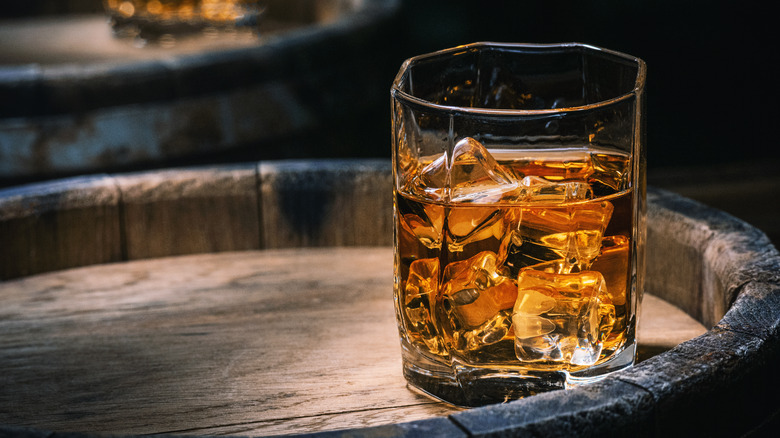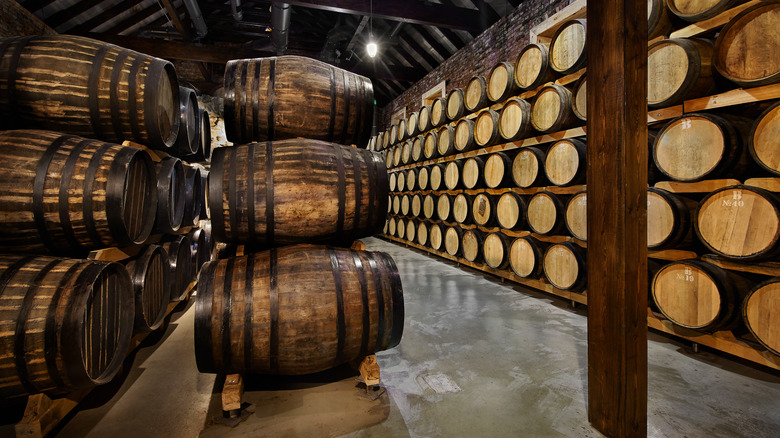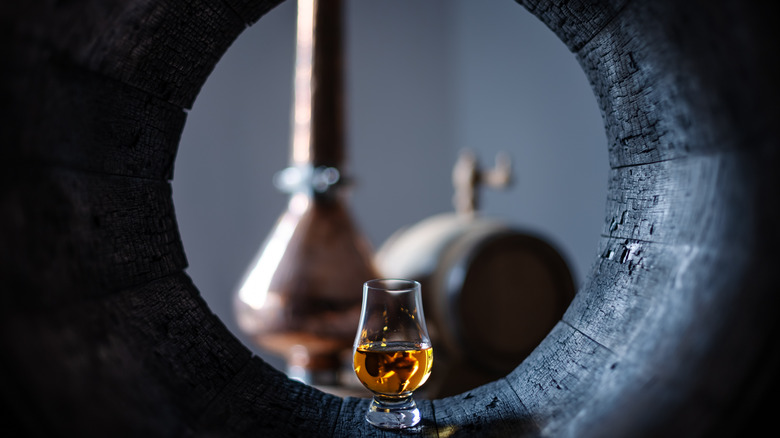How Long Does It Really Take To Make A Barrel Of Bourbon?
When it comes to most food and drinks, preparation can take from a few minutes to a day or two, if the food needs to marinate or rest. With most alcoholic beverages, though, not so fast. Although some beverages such as the fermented pineapple drink tepache take a couple of days from start to finish, some red wines are intentionally aged for decades before they are consumed. If you're a whiskey drinker, you may be wondering how long the process of creating bourbon takes. Are we talking days or decades here?
Generally, it falls somewhere in the middle, which is a pretty vague range. Making bourbon generally takes a matter of days — some commercial distillers estimate about a week from solid grain to liquid booze, most of which is spent fermenting. After fermentation, bourbon needs to be aged, although in many cases there's no official standardization on how long that takes. For that reason, the whole process of making bourbon can take as little as a week or as long as 10 years. But the four-to-six-year range seems to be where most commercially sold bourbons fall.
PYT (Pretty Young Tipple)
Regarding whiskey, aging refers to how long the spirit spends in contact with its wooden container. Although wine continues aging after it's bottled, whiskeys do not get any "older" once they have gone from barrel to bottle. Even after a decade in your liquor cabinet, a four-year-old bourbon will still be considered a four-year-old bourbon.
All bourbons need to be aged in charred new oak barrels to be called "bourbon" under U.S. law. But in most cases, the law doesn't specify how long the bourbon needs to be in the barrel — it's up to the maker whether the spirit stays in its oak container for 10 seconds or 10 years.
Two categories of bourbon do have specific legal requirements for aging: Bourbon sold as "straight" and bourbon sold as "bottled in bond." These two classifications also must meet purity standards. "Straight" bourbon cannot be mixed with any other spirit and has a minimum aging time of two years. "Bottled in bond" bourbons are also unblended but require four years of aging. Most bourbons don't bear these certifications, so distillers can age them for however long they choose.
A bourbon can even be "flash aged," meaning it comes in contact with the oak barrel for as little as just a few seconds yet still meets the legal definition of "aged" bourbon. However, most bourbons fall into that four-to-six-year range. Jim Beam, for instance, is aged for four years; and Maker's Mark is aged for six or seven.
Why age whiskey
Legally, bourbon must be aged in new oak barrels that have been charred. Over time, some qualities of the burnt wood transfer to the bourbon; the longer the bourbon is aged, the more pronounced those qualities become. Those flavor notes can range from sweet, vanilla, and caramelly to smoky and peppery. The burnt wood is the source of many of these flavors, explaining why whiskey is only "aging" while it's in physical contact with the charred oak. Aging is also what makes whiskey and other spirits turn brown, as the color from the barrel leaches into the spirit. (That's why unaged spirits, such as most vodkas, are clear.)
The longer a spirit is aged, typically, the more it costs the distillery to make, which is why older spirits generally cost more at the liquor store. Likewise, minimally aged spirits can turn a profit more quickly. Most commercial distillers find that four to six years, however, is the perfect middle ground to achieve the taste and color customers want.
Aging is responsible for the qualities that people most appreciate about bourbon, but longer aging isn't always necessarily better. The wood imparts a lot of lovely flavors, but given too much time, it can also give the spirit some unwanted astringency, which causes that dry feeling in your mouth. Ultimately, it's all about balance.


